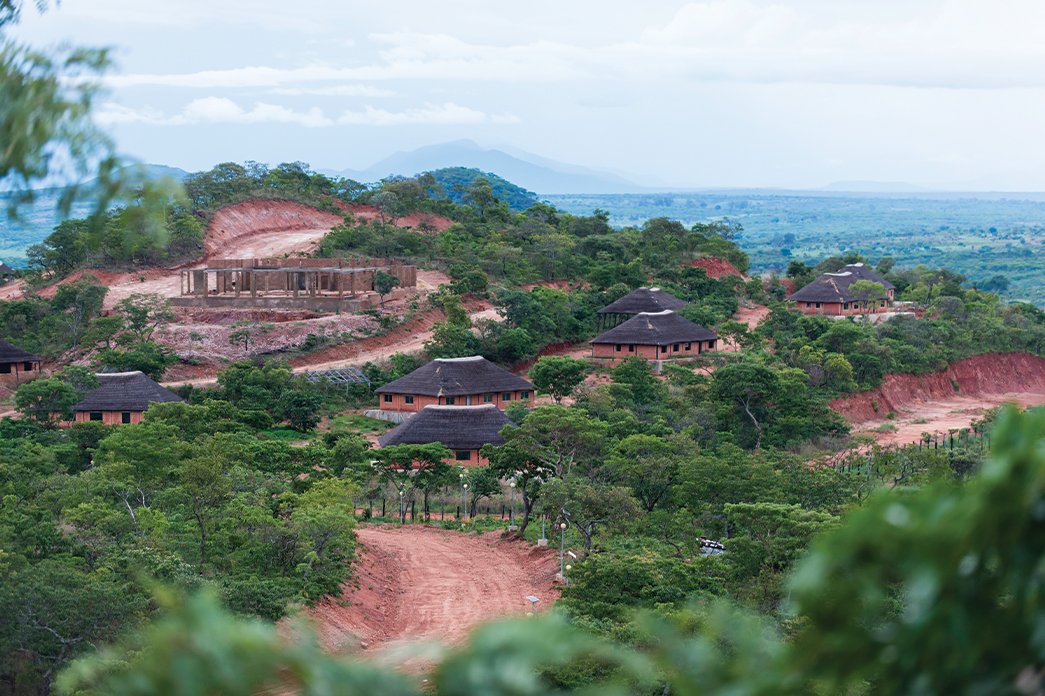Aldeia Camela Amões
An enchanted place covered by a star
In front of the Lumbanganda mountain range, in a region permeated with ancient stories and legends, kings, sobas and lush landscapes, peppered with red earth, stands Aldeia Camela Amões, a project executed over an area of 40,000 hectares, with spaces for housing, education, health, churches, shops, leisure, farmland, livestock, industry, forestry, tourism and a wildlife reserve. Located in the municipality that was once called Bela Vista, now Catchiungo, and with a social purpose never before seen in Angola, Aldeia Camela Amões aims to enhance the value of communities, often forgotten, in rural areas.
In the first phase, which runs from 2014 to 2025, an investment of 400 million dollars is planned for various infrastructures, all built as the resident population grows and in line with demand from visitors. As agricultural production focuses more on potatoes and tomatoes, two factories may soon be built, one for potato processing and the other for tomato processing. António Segunda Amões’ dream was impressive, as his son Faustino points out: «Our father knew South Africa well, with its strong economy. He wanted a bit of that country for Camela Amões. He envisioned wide streets, with everything electrified and, for the agricultural process, he wanted to bring in Angolans trained in agronomy.»
When we walk through the levelled streets of the village, we see that there are traffic lights, even though there isn’t much traffic. The aim is to educate the population that lives there, as most of them, when they go to cities, find it hard to adapt and, as there are already many motorbikes and machinery in constant movement, these traffic lights are considered a road safety measure.
«António Segunda Amões’ dream was impressive»
Aldeia Camela Amões incluces thirty surrounding villages, and the social house, valued at 8 million Kwanzas, are handed over with everything the new owners might need, from furniture, kitchen equipment and even crockery and bed linen. But these are not just given to the residents. They are all owned by a housing cooperative and will be paid for by the residents themselves over a period of 40 years. However, they don’t pay for them in cash, rather in agricultural produce. In other words, a family that signs up for this housing model ends up also being part of the agricultural cooperative. This institution delivers everything that is necessary for the residents to produce food, and the family gives the cooperative between 10 to 15% of its production and a further 10% to amortise the price of the house. Surplus produce can also be sold to the cooperative for selling on. A villager, who had little or nothing will become, in Aldeia Camela Amões, an owner, and the sale of his surplus production will boost the region’s economy.
The energy used in this charming place comes from solar panels and the water comes from several boreholes, and is suitable for human consumption. The return on this investment is also derived from tourism – although this is still in its initial phase, many visitors are already to be seen strolling around the village, mostly out of curiosity, perhaps because they’ve heard about it, as this project was recognised at the Global Summit for Trade and Investment in Africa, held in the USA, in Washington DC, for its social dimension in the creation of productive sectors in rural areas and for bringing value to local communities.
Currently, as an attraction, there is already a fenced area with some wild animals, such as zebras, antelopes, buffalos and others, while the construction of artificial ponds for ducks, geese and fish is planned. For overnight accommodation, Faustino Amões explains: «Tourists can choose from 15 South African style bungalows, set into the mountain, and soon a hotel with 30 rooms and a communal pool.» There are also restaurants serving traditional Angolan food and several streets to walk and discover who they have been named after. «All the streets of the village are named after people who have lived here and each of them has a story. It is good that we, Angolans, or even foreigners, come here to learn about this legacy,» stresses Moisés Amões, who among other activities is a teacher in one of the village schools. In addition to this, in every corner of these huge streets, there are always the delightful smiles of children who are sure to have a promising future. Equally, one of the most important financial institutions, Banco Angolano de Investimentos, has invested in Aldeia Camela Amões and soon the approximately three thousand residents will be able to do their banking.
«Aldeia Camela Amões comprises thirty surrounding villages»
This very unique village has, contrary to expectations, a Soba, Cassinda Muenecongo, mother of three children, who is the head of the village and was elected in 2018, uncontested, by the council of elders. A granddaughter of Prata Camela, Cassinda says: «The village does not have many problems, but sometimes I have to remind careless people not to let their cattle walk in the street, otherwise everything is calm.» Studies have also found that under some points of this amazing village there are several high quality water springs, so it is expected that soon we will see the construction of a mineral water factory.
In conclusion, Aldeia Camela Amões uses its rural setting to combat poverty and enable a dignified lifestyle for the population living in vulnerable contexts. Besides farming and livestock raising, various factories, commerce and services, there is also tourism, which finds fertile ground here for various sectors, from religious to rural, not forgetting game. viewing and safaris, among many others. This project is only in the beginning, and one day, perhaps in a not-too-distant time, António Segunda Amões’ dream will be replicated throughout the African continent, making this piece of land an example for the rest of the world.























